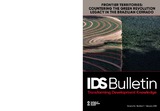Frontier Territories: Countering the Green Revolution Legacy in the Brazilian Cerrado
| dc.contributor.author | Cabral, Lídia | |
| dc.contributor.author | Sauer, Sérgio | |
| dc.contributor.author | Shankland, Alex | |
| dc.coverage.spatial | Brazil | en |
| dc.date.accessioned | 2023-02-01T16:36:29Z | |
| dc.date.available | 2023-02-01T16:36:29Z | |
| dc.date.issued | 2023-02-06 | |
| dc.identifier.citation | Cabral, L.; Sauer, S. and Shankland, A. (2023) 'Frontier Territories: Countering the Green Revolution Legacy in the Brazilian Cerrado', IDS Bulletin 54.1, DOI: 10.19088/1968-2023.100 | en |
| dc.identifier.issn | 1759-5436 | |
| dc.identifier.uri | https://opendocs.ids.ac.uk/opendocs/handle/20.500.12413/17859 | |
| dc.description.abstract | Brazil is recognised as a world leader in the production of agri-food commodities in large, highly mechanised farms, but also as a centre of resistance movements advocating for land rights and food sovereignty. Brazil’s portrayal as a success story of agricultural modernisation is invariably linked to the expansion of the production frontier and, specifically, the conversion of the Cerrado region into industrial farmland. A vast savannah zone in the centre of the country, the transformation of the Cerrado region has been driven by intensive soybean and livestock production for export. However, the Cerrado ‘miracle’ has come at a high cost. Besides the environmental impacts of land clearance and the removal of native vegetation, the expansion of the frontier has exacerbated poverty and injustice, deepening the historical inequality of land distribution and wealth. This issue of the IDS Bulletin highlights the legacy of tensions in the Cerrado, arguing that this legacy cannot be ignored in debates on global agri-food systems to which the region is increasingly central. Authored mainly by early career scholars from Brazilian and British universities, the papers here offer new research and empirical material on the battles that have engulfed people and nature in the Cerrado. Three themes emerge: the logic of extraction in an agricultural frontier; the grabbing of natural resources in the name of sustainability; and conflicts and resistance movements. This IDS Bulletin concludes with an agenda for research and action to reclaim the Cerrado, alongside other agricultural frontier territories across the world, as part of the global effort towards sustainable transformation of agri-food systems to secure justice for nature and people alike. | en |
| dc.description.sponsorship | Newton Fund Researcher Links Workshops grant, ID 2019-RLWK11-10177 | en |
| dc.description.sponsorship | UK Department for Business, Energy and Industrial Strategy | en |
| dc.description.sponsorship | Fundação de Apoio a Pesquisa do Distrito Federal (FAPDF), Brazil | en |
| dc.description.sponsorship | British Council | en |
| dc.description.sponsorship | UK Economic and Social Research Council, ID ES/R00658X/1 | en |
| dc.language.iso | en | en |
| dc.publisher | Institute of Development Studies | en |
| dc.relation.ispartofseries | IDS Bulletin;54.1 | |
| dc.rights | This is an Open Access issue distributed under the terms of the Creative Commons Attribution 4.0 International licence (CC BY), which permits unrestricted use, distribution, and reproduction in any medium, provided the original authors and source are credited and any modifications or adaptations are indicated. http://creativecommons.org/licenses/by/4.0/legalcode | en |
| dc.rights.uri | http://creativecommons.org/licenses/by/4.0/ | en |
| dc.subject | Agriculture | en |
| dc.subject | Development Policy | en |
| dc.subject | Environment | en |
| dc.subject | Politics and Power | en |
| dc.subject | Rights | en |
| dc.title | Frontier Territories: Countering the Green Revolution Legacy in the Brazilian Cerrado | en |
| dc.type | Article | en |
| dc.rights.holder | Institute of Development Studies | en |
| dc.identifier.team | Rural Futures | en |
| dc.identifier.doi | 10.19088/1968-2023.100 | |
| dcterms.dateAccepted | 2023-02-06 | |
| rioxxterms.funder | Default funder | en |
| rioxxterms.version | VoR | en |
| rioxxterms.versionofrecord | 10.19088/1968-2023.100 | en |
Files in this item
This item appears in the following Collection(s)
Except where otherwise noted, this item's license is described as This is an Open Access issue distributed under the terms of the Creative Commons Attribution 4.0 International licence (CC BY), which permits unrestricted use, distribution, and reproduction in any medium, provided the original authors and source are credited and any modifications or adaptations are indicated. http://creativecommons.org/licenses/by/4.0/legalcode


